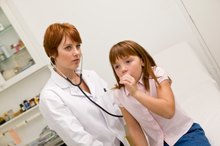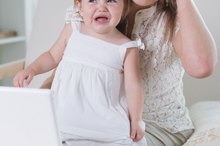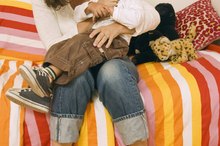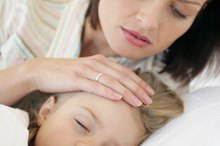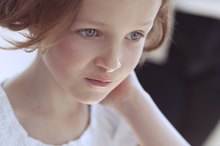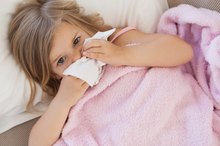Wheezing in 2-Year-Olds
Wheezing is a high-toned whistle-like noise that occurs while breathing, typically when exhaling. It can occur in anyone, including a 2-year-old child. The sound transpires as air attempts to flow through breathing tubes that have narrowed due to an illness, condition or complication. Because wheezing makes breathing difficult, it is essential to understand why it occurs and how you can ease your child’s symptoms.
If you are experiencing serious medical symptoms, seek emergency treatment immediately.
Causes
Wheezing often develops in 2-year-olds who contract a lower-respiratory infection like the respiratory syncytial virus, or RSV. Wheezing also develops if your child’s throat becomes obstructed by an object and he begins to choke. Asthma, allergens, certain bugs, pollen, foods or drugs can also trigger wheezing 2. In addition, abnormalities in the structure of the vocal cords or airways also can cause wheezing in 2-year-olds.
- Wheezing often develops in 2-year-olds who contract a lower-respiratory infection like the respiratory syncytial virus, or RSV.
- In addition, abnormalities in the structure of the vocal cords or airways also can cause wheezing in 2-year-olds.
Remedies
Seal-Like Cough in Children
Learn More
Turn on a hot shower until the air in the bathroom becomes steamy and thick. Sit with your 2-year-old in the bathroom so he can breathe in the wet, warm air, which will help ease wheezing episodes. Alternatively, run a vaporizer in various rooms of your house to add moisture to the air. A doctor often prescribes an asthma medication or inhaler to stop wheezing related to asthma attacks 2.
- Turn on a hot shower until the air in the bathroom becomes steamy and thick.
- Sit with your 2-year-old in the bathroom so he can breathe in the wet, warm air, which will help ease wheezing episodes.
Prevention
Keep your toddler away from irritants such as cigarette smoke, air pollution, fireplace smoke and dust, all of which can trigger wheezing episodes. Wash her bedding in hot water once a week to reduce allergen exposure. Because pollutants are irritating to the lungs and contribute to wheezing, check the air quality index in your area and keep your child indoors when air quality outside is unsafe for those with respiratory conditions.
Dangers
My Two Year Old Is Throwing Up & Has Rapid Respiration
Learn More
Call your child’s pediatrician or go to the emergency room if your toddler experiences unexplained wheezing or if the episodes are chronic, do not subside even with home treatment or are accompanied by breathing difficulties, problems with concentration or comprehension, the development of hives, swelling in the throat or the skin turning blue. These are signs of a serious allergic reaction or complication.
Related Articles
References
- MedlinePlus; Wheezing; June 10, 2010
- BabyCenter: Asthma
- BabyCenter: Allergies
- Mayo Clinic; Wheezing in Children: Could it Be Asthma?; Jay L. Hoecker, M.D.; May 25, 2011
- Behrman: Nelson Textbook of Pediatrics, 18th ed.
Writer Bio
Rose Erickson has been a professional writer since 2010. She specializes in fitness, parenting, beauty, health, nutrition and saving money, and writes for several online publications including The Krazy Coupon Lady. She is also a novelist and a mother of three.
